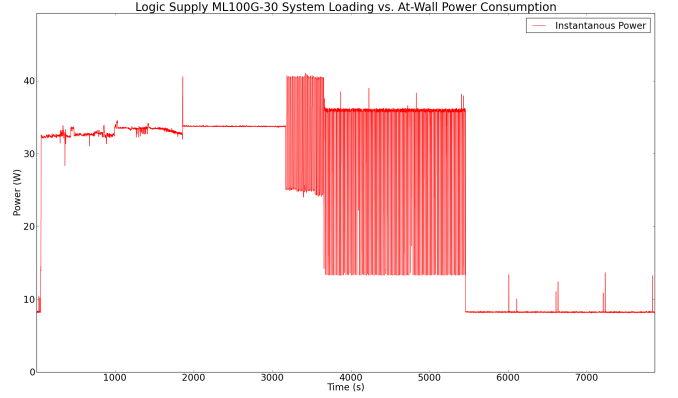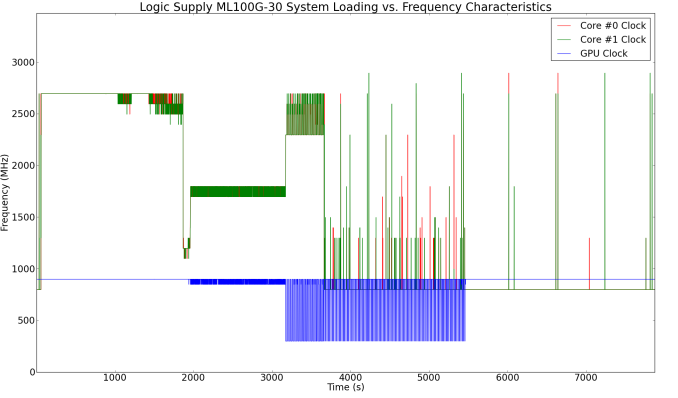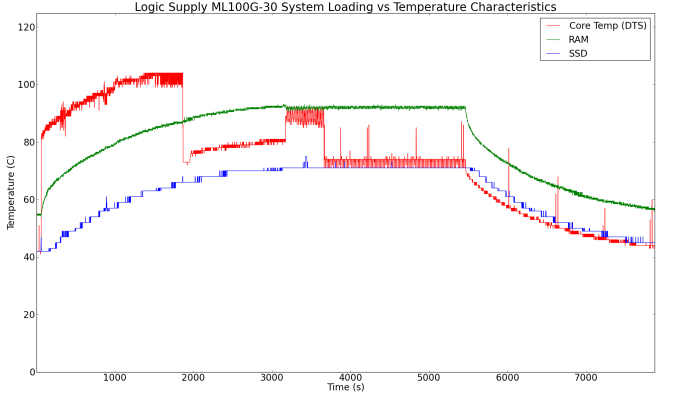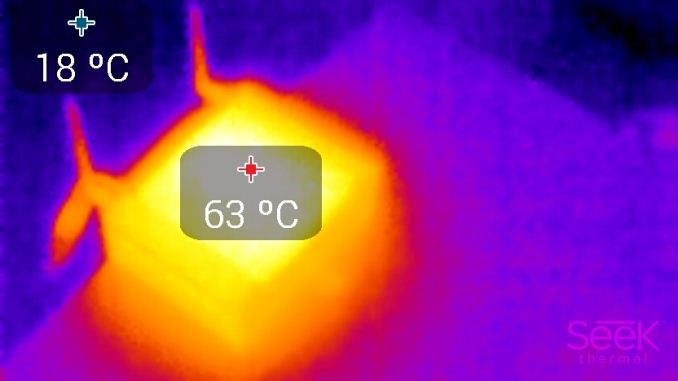Logic Supply ML100G-30 Fanless Broadwell vPro Industrial NUC Review
by Ganesh T S on April 29, 2015 11:30 AM EST- Posted in
- Systems
- Intel
- Fanless
- NUC
- Industrial PC
- Passive Cooling
- Logic Supply
Power Consumption and Thermal Performance
The power consumption at the wall was measured with a 1080p display being driven through one fo the mini-DP porst. In the graphs below, we compare the idle and load power of the Logic Supply ML100G-30 with other low power PCs evaluated before. For load power consumption, we ran Furmark 1.12.0 and Prime95 v27.9 together. Despite the lack of active cooling, the idle power consumption is a bit too high for our liking (considering that we are operating in single-channel memory mode). This may be due to a number of factors - idle power of the Transcend SSD not being particularly attractive and/or power supply inefficiencies and/or vPro as a platform itself may show some increase in idle power consumption. We didn't explore this in enough detail to root cause the behavior.


The load power graph is much more interesting. Even though the system could consume up to 40.56 W, it does not sustain this for an extended duration. This aspect will become evident in the graphs below.
In order to evaluate the efficiency of the thermal design, the at-wall power consumptio as well as the frequencies of the various clocks in the systems and the temperature of the various components in the system were recorded in the course of our thermal stress test. We start with the system at idle, followed by 30 minutes of pure CPU loading. This is followed by another 30 minutes of both CPU and GPU being loaded simultaneously. After this, the CPU load was removed, allowing the GPU to be loaded alone for another 30 minutes.
A look at the power consumption at the wall reveals that the unit has a steady state maximum load power consumption around 34 W, but it can spike up to 40 W if needed. A context to the above graph is given by the frequency and temperature graphs below for the same time span.
The most important thing to observe with the temperature graph is that DTS never goes to 0 - so, junction temperature is never reached. This is achieved by dialing down the core frequency from 2.7 GHz to 2.5 GHz. Since the Core i5-5300U is rated for a 2.3 GHz operation, one shouldn't term this as throttling.
Loading up both the CPU and GPU results in some strange behavior - they manage to share the available headroom by operating between 1.7 GHz - 1.8 GHz and 850 MHz - 900 MHz respectively. However, after around 20 minutes of this sharing, something strange kicks in despite the temperatures and at-wall power consumption being largely stable - the GPU starts oscillating between 300 MHz and 900 MHz, while the CPU cranks up to 2.3 GHz - 2.6 GHz. The temperature also rises correspondingly from 76 C to around 87 C. Removing the CPU load brings the cores to idle at 800 MHz, while the GPU continues to oscillate between 300 MHz and 900 MHz. The thermal solution is able to keep the cores idle around 43 C.
Another important aspect to keep note of while evaluating fanless PCs is the chassis temperature. Using Seek Thermal's thermal imager, we observed the chassis temperature after the at-wall power consumption started the 40 W peaks.
We also took thermal photographs of the other parts of the chassis and they are presented in the gallery below.
The chassis temperatures peak around 65 C, which is a marked improvement over the 80 C we observed in the Core ML320 last year. The ML100G-30 has a better chassis design from a thermal viewpoint and it is made possible due to the increased height of the unit (compared to the ML320).




















34 Comments
View All Comments
Pissedoffyouth - Wednesday, April 29, 2015 - link
I have a build based on an Minibox M350 - designed for passive heatsinks or CPU's with fan and <65w TDP.With an A10-7800 it completely smokes these little boxes at a similar size, and for less money.
I'd love to see a NUC with an AMD APU and some decent cooling design
damianrobertjones - Wednesday, April 29, 2015 - link
I have an i7 quad machine that smokes your M350 machine. It's bigger than the Minibox but, then again, your minibox is bigger than the above Nuc.nathanddrews - Wednesday, April 29, 2015 - link
Oh yeah? Well epeen, epeen, epeen!TheinsanegamerN - Wednesday, April 29, 2015 - link
And my desktop smashes both of yours put together. Do I win?Pissedoffyouth - Wednesday, April 29, 2015 - link
Smokes it? What i7? I bet its GPU is worseSamus - Wednesday, April 29, 2015 - link
Broadwell's i7-5557U GPU is pretty damn close to a 192-core GCN GPU but nowhere near a 384+ core GCN GPU such as that in the A10. But it's also 1/4th the TDP, so half the GPU performance and 20% more CPU performance is all well unless you actually plan to game (at low res) on the thing because lets be honest here, both GPU's are unacceptable for HD gaming.It's also worth pointing out the Intel GPU is substantially more advanced regarding features and modern codec support.
blue_urban_sky - Thursday, April 30, 2015 - link
I presumed he was pointing out that if you are using a bigger chassis then it is easy to get a faster system. Your system is 192 x 210 x 62 (2.5l) this is 142 x 62 x 107 (0.95l)Haravikk - Thursday, April 30, 2015 - link
I have an i7-4790T in an Akasa Euler case; I believe it's around the size of the M350, similar price too (at least here in the UK) but a fully aluminium case designed as a heat-sink. The 4790T is 45W, but runs extremely well in the case; running a 1080p encode in Handbrake it can hold 750% CPU use (where all 8 threads is 800%) at a speed of 3ghz, even though it's normal operating speed is 2.7ghz.The only issue with this setup is that mSATA drives are out, as too much heat builds up in the case; I had to swap for a regular 2.5" SSD, and I did put a tiny 40mm Noctua fan in just to help clear the heat build up under heavy load (during normal use it switches off completely).
I'm not aware of any Broadwell compatible thin mini-ITX boards yet, but I imagine doing the same again with Broadwell could achieve even better results.
It does make me wonder why so many of these boxes have such anaemic CPU options, as it's clearly possible to put fairly powerful CPUs in. In fact, my (mostly) passive system replaced a 2008 dual quad-core Mac Pro, and outperforms it in almost every metric in such a tiny system. No ECC of course, but otherwise it's a pretty big (or small) change.
Pissedoffyouth - Thursday, April 30, 2015 - link
That does look like a pretty decent casenatenu - Sunday, May 10, 2015 - link
One of the reasons industrial PCs have lower powered CPUs is not only for thermal reasons but in order to have an industrial control panel be UL 508 approved any PC inside of it needs to be powered by a class 2 DC power supply. That is a power supply that cannot supply more than 100 watts.